How to Train Clients With Anxiety Disorders (Step-by-Step Guide)
Understanding how to train clients with anxiety disorders can lead to an influx of new clients for personal trainers. But it’s essential that you’re equipped with the right tools and knowledge to train someone with an anxiety disorder safely and effectively. Incorporating specific features of personal training software can assist in achieving this. Learn how to train clients with anxiety disorders and what tools are needed in this comprehensive guide.
- Training clients with anxiety disorders necessitates a thoughtful approach to exercise prescription. For example, emphasizing mindfulness and relaxation techniques can be beneficial.
- Most clients with anxiety disorders will appreciate a calming and stress-free environment. High-intensity workouts might not be suitable for all; moderate-intensity workouts with mindful components may be more appropriate.
- Utilizing workout and assessment software can help ensure your client’s safety and promote their progress towards their fitness goals without undue stress.
Diversifying your personal training business by focusing on special populations, like clients with anxiety disorders, can provide a rewarding way to increase your revenue.
Training clients with anxiety disorders requires not just an understanding of the condition but the right tools to facilitate effective training – that’s where personal training software comes in.
By harnessing the features of the best online personal training software, you can train clients with anxiety disorders in a way that works for them and promotes their wellbeing.
Get the best personal training software from Exercise.com by booking a demo now!
Understanding Anxiety Disorders: A Primer for Fitness Professionals
Anxiety disorders can be challenging for both the individuals experiencing them and the fitness professionals working with them. In order to provide effective training for clients with anxiety disorders, it is crucial to have a comprehensive understanding of these conditions and their impact on physical health. This article aims to equip fitness professionals with the knowledge and strategies necessary to create an inclusive and supportive environment for clients with anxiety disorders, tailor exercise programs to individual needs, and address safety concerns related to anxiety symptoms. By collaborating with mental health professionals and continuously educating themselves, fitness professionals can make a positive impact on the lives of their anxious clients.
Anxiety disorders are a group of mental health conditions characterized by excessive and persistent feelings of fear, worry, and apprehension. Fitness professionals must understand that anxiety disorders are not simply a matter of being nervous or stressed, but rather, they are complex disorders that can significantly affect an individual’s daily life. Common types of anxiety disorders include generalized anxiety disorder, panic disorder, social anxiety disorder, and specific phobias. Each type of anxiety disorder presents unique challenges and requires tailored approaches in training. Fitness professionals should familiarize themselves with the symptoms, diagnostic criteria, and recommended treatments for these disorders to provide effective support for their clients.
Generalized anxiety disorder (GAD) is characterized by excessive and uncontrollable worry about everyday events or activities. People with GAD often experience physical symptoms such as restlessness, fatigue, muscle tension, and difficulty concentrating. It is important for fitness professionals to be aware of these symptoms, as individuals with GAD may require modifications to their exercise routines to manage their anxiety effectively.
Panic disorder is another common type of anxiety disorder, characterized by recurrent and unexpected panic attacks. Panic attacks are intense episodes of fear and discomfort, accompanied by physical symptoms such as rapid heartbeat, shortness of breath, dizziness, and chest pain. Fitness professionals should be prepared to provide a calm and supportive environment for individuals with panic disorder, as well as educate themselves on techniques to help manage panic attacks during exercise.
The Prevalence of Anxiety Disorders Among Clients: Statistics and Trends
Anxiety disorders are highly prevalent among the general population, with millions of individuals worldwide experiencing these conditions. According to recent statistics, approximately 18% of adults in the United States alone have an anxiety disorder. Fitness professionals should be prepared to encounter clients with anxiety disorders and understand the significance of these conditions in the overall population. By being aware of the prevalence of anxiety disorders, fitness professionals can better anticipate the needs of their clients and tailor their training approaches accordingly.
The Impact of Anxiety on Physical Health: Recognizing the Connection
While anxiety disorders primarily manifest as mental health conditions, their effects can extend to physical health as well. Individuals with anxiety disorders may experience symptoms such as rapid heart rate, shortness of breath, muscle tension, and changes in appetite. These physical symptoms can be distressing and may hinder an individual’s ability to engage in regular exercise. Fitness professionals must recognize the interplay between anxiety and physical health to effectively train clients with anxiety disorders. By addressing both the mental and physical aspects of anxiety, fitness professionals can help clients improve their overall well-being.
Identifying Different Types of Anxiety Disorders in Clients
When working with clients, it is crucial to identify the specific type of anxiety disorder they may be experiencing. Generalized anxiety disorder is characterized by excessive worry and chronic anxiety about various aspects of life, while panic disorder involves recurrent panic attacks accompanied by intense fear and physical symptoms. Social anxiety disorder involves excessive self-consciousness and fear of social situations, whereas specific phobias are irrational and intense fears of specific objects or situations. By understanding the unique features of each anxiety disorder, fitness professionals can tailor their training programs to address the specific needs and concerns of their clients with precision.
Creating an Inclusive and Supportive Environment for Clients with Anxiety Disorders
Anxiety disorders can make individuals feel isolated and misunderstood. Fitness professionals can play a crucial role in creating a supportive and inclusive environment for their clients. By demonstrating empathy, patience, and understanding, fitness professionals can help alleviate the anxiety their clients may experience during training sessions. It is important to foster an atmosphere where clients feel safe to express their concerns, ask questions, and communicate their needs. Building trust and rapport is essential in ensuring that clients with anxiety disorders feel comfortable and empowered to embark on their fitness journey.
Building Trust and Rapport with Anxious Clients: Effective Communication Strategies
Effective communication is key when working with clients with anxiety disorders. Fitness professionals should approach their interactions with empathy, active listening, and validation. It is important to give clients the space to express their anxieties, fears, and expectations. By demonstrating genuine interest and understanding, fitness professionals can build trust and rapport with their anxious clients. Additionally, clear and concise instructions regarding exercises, modifications, and progressions can help alleviate anxiety and increase confidence during training sessions. Fitness professionals should also be mindful of their tone and body language, aiming to create a positive and supportive atmosphere for their clients.
Tailoring Exercise Programs to Suit Individual Needs and Comfort Levels
Every client with an anxiety disorder has unique needs and comfort levels. Fitness professionals should take a client-centered approach to designing exercise programs, considering factors such as fitness goals, physical capabilities, and personal preferences. It is important to create a balanced and progressive program that gradually challenges clients while respecting their limitations. By incorporating variety and flexibility into the exercise routine, fitness professionals can help clients stay engaged and motivated. Evaluating progress regularly and adjusting the program accordingly ensures that clients feel a sense of achievement and continuous improvement.
Gradual Exposure Therapy: A Step-by-Step Approach to Training Anxious Clients
Gradual exposure therapy is a technique commonly used in the management of anxiety disorders. Fitness professionals can utilize this approach by slowly exposing anxious clients to feared situations or exercises. By starting with less anxiety-provoking activities and gradually progressing to more challenging ones, clients can develop coping strategies and build confidence over time. Fitness professionals should collaborate with their clients to set realistic goals and track progress. The key is to strike a balance between pushing clients out of their comfort zones and ensuring their emotional and physical well-being.
Incorporating Mindfulness and Relaxation Techniques in Training Sessions
Mindfulness and relaxation techniques can significantly benefit clients with anxiety disorders during training sessions. Fitness professionals can guide their clients through mindfulness exercises, deep breathing, and progressive muscle relaxation to help reduce anxiety and promote overall relaxation. These techniques can be incorporated into warm-up and cool-down routines, as well as during rest periods between exercises. By creating moments of calm and centering, fitness professionals can enhance the overall training experience for individuals with anxiety disorders.
Addressing Safety Concerns: Managing Panic Attacks during Workouts
Individuals with anxiety disorders are more prone to experiencing panic attacks, particularly in situations where they feel overwhelmed or triggered. Fitness professionals should familiarize themselves with the signs and symptoms of panic attacks and be prepared to manage them effectively. Creating a safe and non-judgmental environment is crucial, as clients need to know they can seek support and take breaks when needed. Fitness professionals can also teach clients grounding techniques, such as focusing on their breath or engaging in sensory activities, to help manage panic symptoms during workouts. Collaborating with mental health professionals can also provide additional guidance in managing panic attacks during training sessions.
Strategies for Encouraging Consistency and Accountability in Anxious Clients
Consistency and accountability are essential in any training program, especially for anxious clients who may struggle with motivation and maintaining routines. Fitness professionals can implement strategies such as goal-setting, tracking progress, and providing positive reinforcement to encourage clients to stay consistent with their exercise regimen. By understanding the unique challenges and barriers faced by individuals with anxiety disorders, fitness professionals can offer tailored support and motivate their clients to overcome obstacles. Creating a sense of accountability through regular check-ins and open communication can also help clients stay committed to their fitness goals.
The Role of Nutrition in Managing Anxiety Symptoms: Dietary Recommendations
While exercise is crucial in managing anxiety symptoms, nutrition also plays a significant role in overall well-being. Fitness professionals can educate their clients about the impact of certain dietary choices on anxiety symptoms and mental health. Recommending a balanced diet that includes whole foods, lean proteins, fruits, vegetables, and healthy fats can support optimal brain function and mood regulation. Reducing the intake of caffeine, refined sugars, and processed foods that may exacerbate anxiety symptoms can also be beneficial. Collaborating with registered dietitians or nutritionists may provide additional guidance and expertise in addressing the nutritional needs of clients with anxiety disorders.
Collaborating with Mental Health Professionals: Holistic Approaches to Client Care
Collaboration between fitness professionals and mental health professionals is essential in providing holistic care for clients with anxiety disorders. Fitness professionals should actively seek opportunities to collaborate and communicate with mental health professionals to ensure a comprehensive approach to client well-being. By sharing insights, progress updates, and concerns, fitness professionals can work in tandem with mental health professionals to create a well-rounded care plan. This collaboration may involve referrals, joint sessions, or regular communication to ensure that clients receive the best possible support.
Tracking Progress and Celebrating Achievements: Motivating Anxious Clients
Tracking progress and celebrating achievements can significantly motivate individuals with anxiety disorders. Fitness professionals should encourage their clients to set achievable goals and celebrate even the smallest milestones. This approach fosters a sense of accomplishment and reinforces their commitment to the training program. Using visual tools such as charts or progress photos can also help clients visually track their progress. By acknowledging their achievements and providing positive feedback, fitness professionals can boost the self-esteem and confidence of their anxious clients.
Case Studies: Success Stories of Training Clients with Anxiety Disorders
Success stories and real-life examples can be powerful tools in motivating anxious clients. Fitness professionals can share case studies or stories of clients who have successfully managed their anxiety symptoms through regular exercise and training. By highlighting the progress, challenges, and positive outcomes of these individuals, fitness professionals can inspire their clients and demonstrate that positive change is attainable. However, it is important to respect client confidentiality and obtain consent before sharing any personal information or identifiable details.
Overcoming Challenges as a Fitness Professional Working with Anxious Clients
Working with clients with anxiety disorders can present unique challenges for fitness professionals. It is important to acknowledge and address these challenges to ensure both professional and personal well-being. Building a support network of colleagues, mentors, and mental health professionals can provide guidance and validation in navigating these challenges. Engaging in regular self-care practices, such as exercise, mindfulness, and seeking professional support when needed, is also vital. Continuous education and professional development in the field of mental health can further equip fitness professionals with the necessary tools and knowledge to effectively train clients with anxiety disorders.
Continuous Education and Professional Development for Effective Training Methods
As the field of mental health continues to evolve, so too should the knowledge and skills of fitness professionals. Continuous education and professional development are crucial for staying updated on the latest research, training methods, and best practices for working with clients with anxiety disorders. Fitness professionals should actively seek out relevant workshops, seminars, or certifications that provide in-depth training in mental health and anxiety management.
By investing in their own professional growth, fitness professionals can better serve their clients and enhance their ability to provide effective training and support.In conclusion, training clients with anxiety disorders requires a thorough understanding of these conditions, their impact on physical health, and tailored approaches to meet individual needs.
Creating an inclusive and supportive environment, building trust, and incorporating strategies such as gradual exposure therapy, mindfulness techniques, and addressing safety concerns are vital in ensuring a positive training experience. Collaborating with mental health professionals and prioritizing continuous education can further enhance the effectiveness of training programs for clients with anxiety disorders. By encompassing a holistic approach, fitness professionals can make a meaningful and lasting impact on the well-being of their anxious clients.
What type of exercise is best for anxiety?
Any form of exercise can help to alleviate anxiety, but some studies suggest that aerobic exercises, such as jogging, swimming, cycling, walking, gardening, and dancing, may be particularly effective. These types of activities can reduce anxiety by helping to lower your body’s stress hormones like cortisol in the long run. They also help stimulate the production of endorphins, chemicals in the brain that act as natural painkillers and mood elevators.
How can coaches help with anxiety?
Coaches can help with anxiety by creating a supportive and non-judgmental environment, setting realistic goals, and offering positive reinforcement. They can also help clients incorporate mindfulness and relaxation techniques into their workouts. By teaching breathing techniques and promoting a balanced approach to exercise, coaches can help individuals use physical activity as a constructive tool to manage anxiety.
How does physical activity help anxiety?
Physical activity helps manage anxiety in several ways. Exercise increases the production of endorphins, which are known to help produce positive feelings and reduce the perception of pain. Regular exercise can also improve sleep, which is often negatively affected by anxiety. Furthermore, exercise can help boost confidence, take the mind off worries, and provide a sense of accomplishment and control that can combat the feelings of helplessness that often accompany anxiety.
What kind of exercise is best for mental health?
Just like with anxiety, any form of exercise can be beneficial for mental health. Aerobic exercises like running, walking, swimming, and dancing have been shown to reduce anxiety and depression. Strength training can also boost mood by increasing levels of brain-derived neurotrophic factor, a protein that helps support the health of your brain’s neurons. Yoga and tai chi can reduce stress levels and improve mood thanks to their combination of physical activity and mindfulness.
Does exercise help panic attacks?
Yes, regular exercise can help reduce the frequency and intensity of panic attacks. Exercise can help regulate the body’s stress response and make it healthier over time, making it a valuable part of a comprehensive treatment plan for panic attacks. However, during a panic attack, intense exercise may mimic the physical sensations of a panic attack and could potentially exacerbate it. Gentle exercises like deep breathing or yoga might be more beneficial in these instances. As always, it’s important for individuals with panic disorder to consult with a healthcare provider to develop an appropriate treatment plan.
Use the Best Personal Training Software to Offer a Stellar Client Experience
Training clients with anxiety requires a comprehensive and tailored approach. See how Exercise.com can help.

To learn more about how Exercise.com can help you run your fitness business, book a demo now!
Creating Training Plans for Clients with Anxiety Disorders
Here’s how you can help your clients accomplish their training goals by using workout plan creator software to create workout plans, run fitness challenges, offer online workout groups, message clients, and more, all from your very own custom branded fitness apps.
Exercise.com stands out as an all-in-one fitness business management software with comprehensive workout plan sales capabilities. The robust member management, billing & invoicing, and unique fitness assessment tools offer a one-stop solution for fitness business needs. Here’s just some of what you can do with the Exercise.com platform:
Engage with clients via automations.
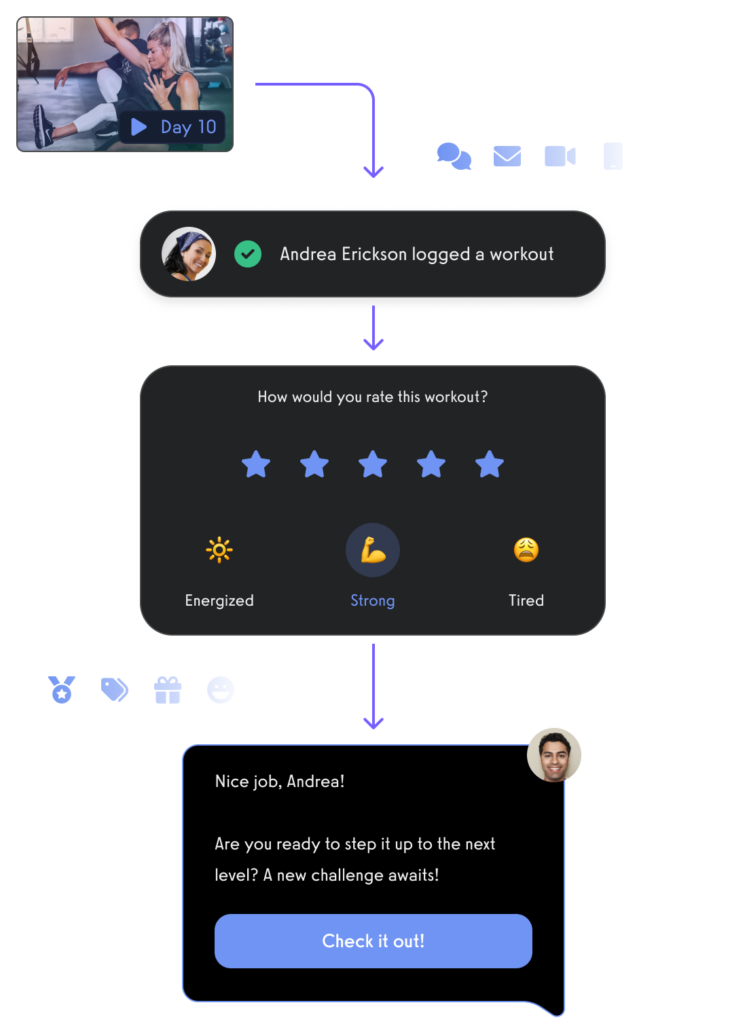
Manage leads with a fitness CRM.
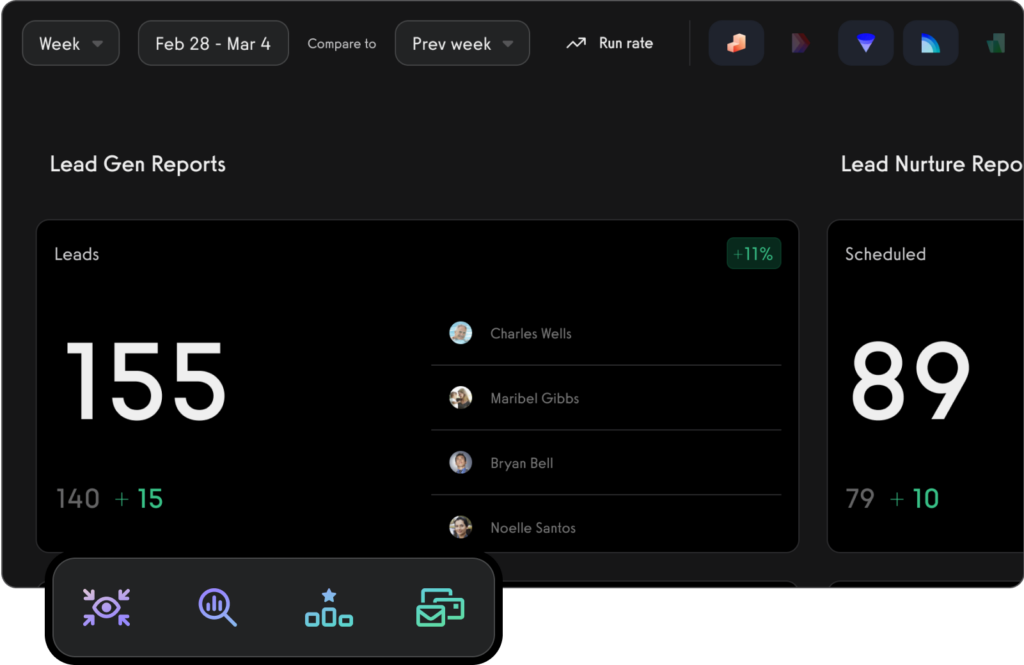
Create and send fitness assessments with ease.
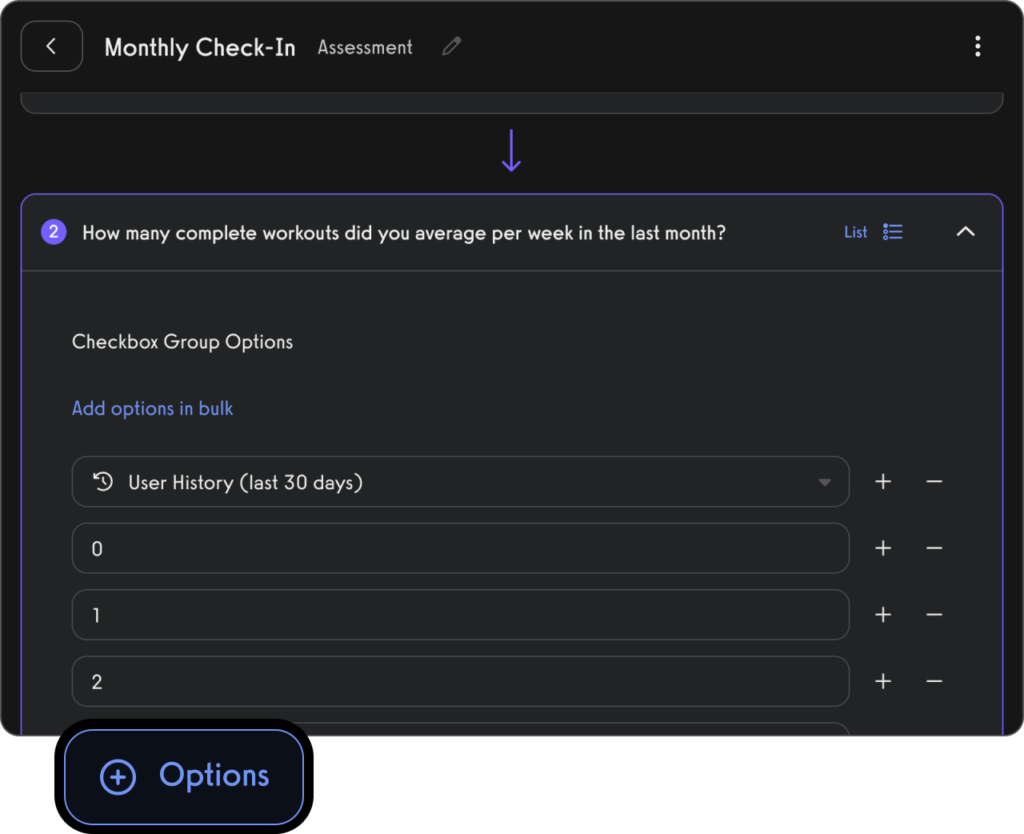
Use fitness habit tracking to inspire and motivate personal training clients (in-person and remote).

Use fitness progress photos to engage with clients.
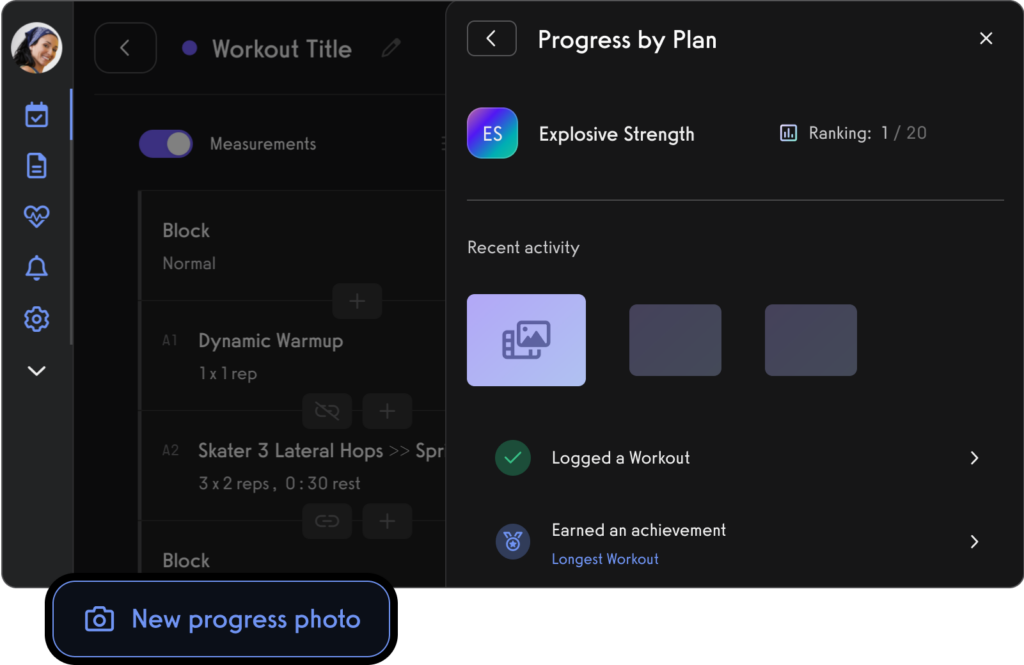
Use fitness leaderboards to track performance and inspire healthy competition.
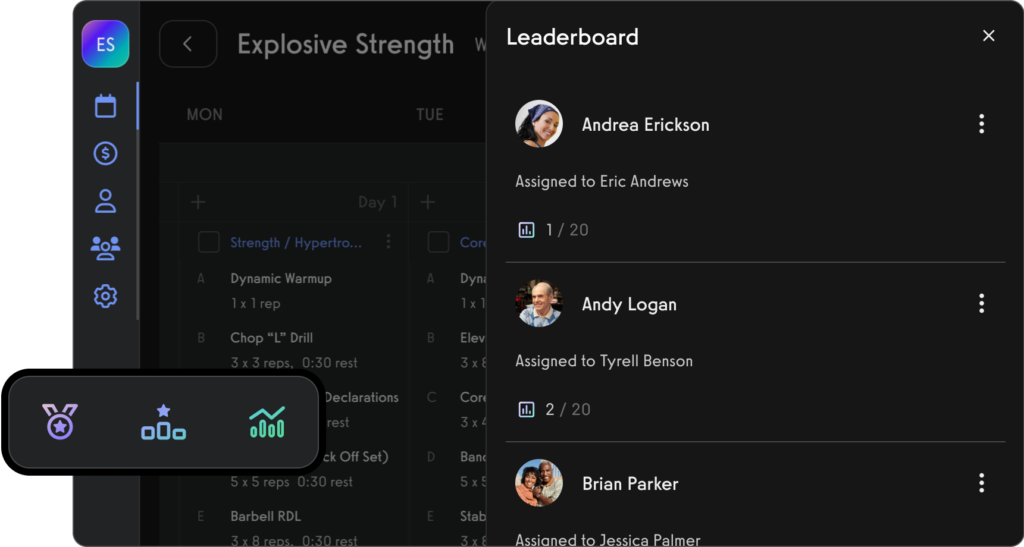
Use the exercise demonstration video library or create your own custom exercise demonstration videos.

Create workout plans for parents and dependents, teams and more.

Manage personal training clients with ease.

Book appointments for clients (Read More: Best Gym Booking Software)

Create classes and fitness groups

Manage fitness challenges (Read More: 100+ Fitness Challenge Ideas)
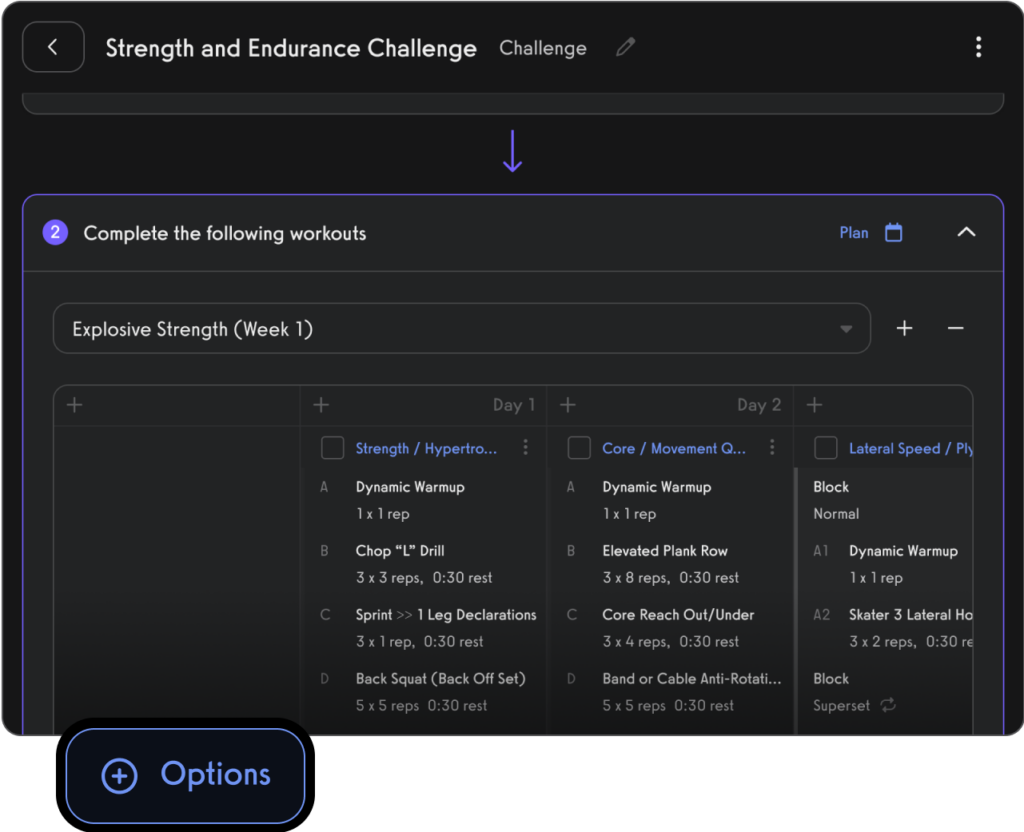
Process payments for open gym, classes, and personal training.

Communicate with gym members, athletes, team members, personal training clients, class members, parents, and dependents via SMS, email, and in-app push notification.
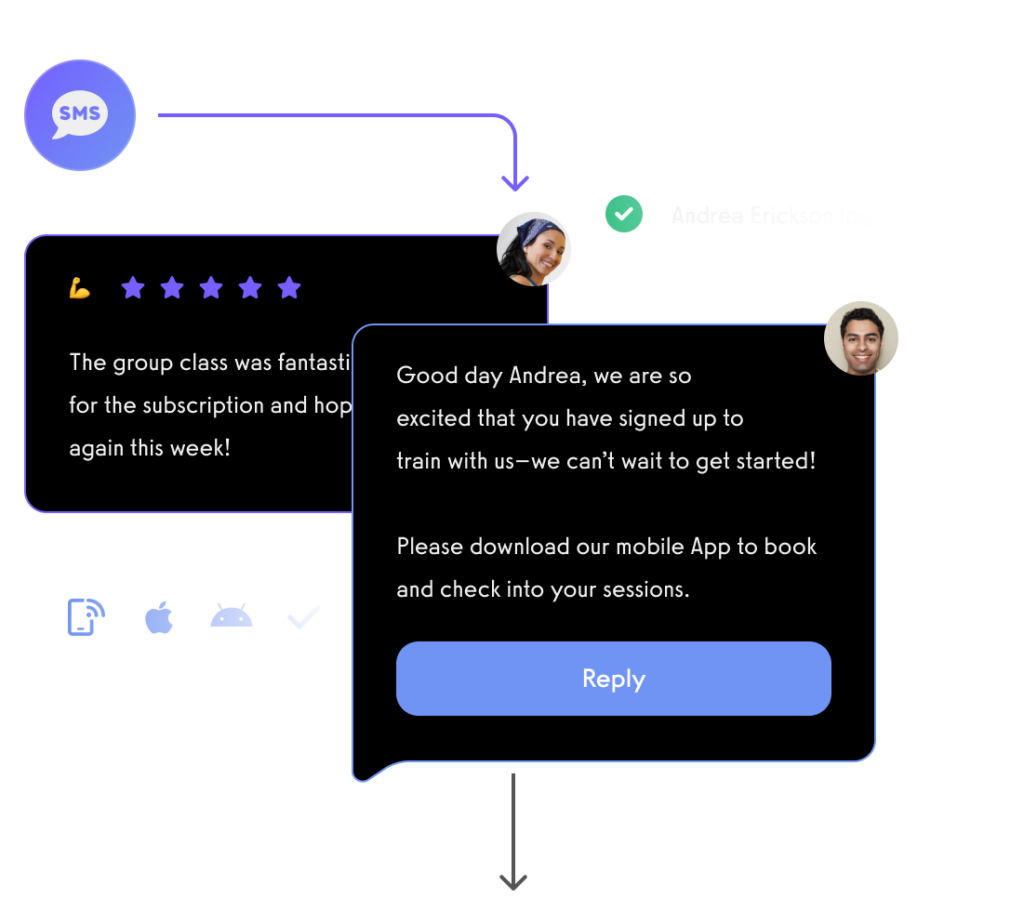
View performance over time, track personal records, and other fitness stats with performance reporting dashboards.
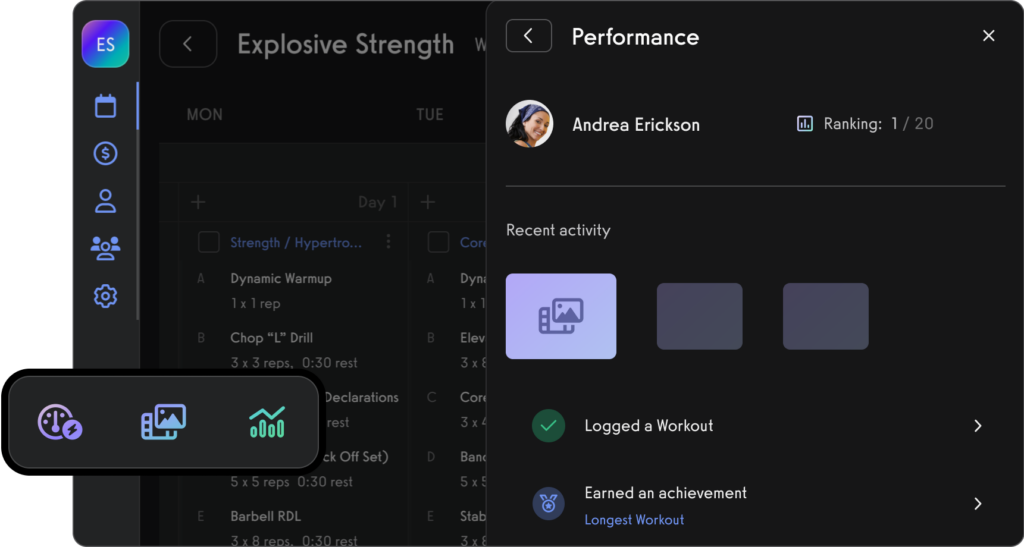
And of course, view all of your fitness business reports easily too.
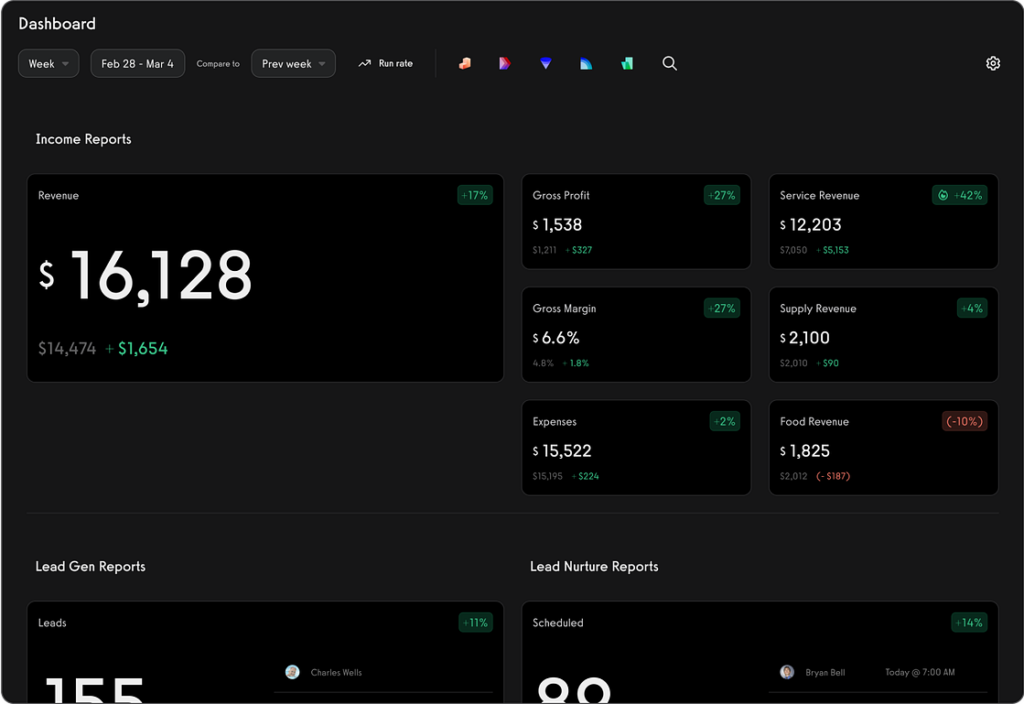
All from your custom-branded fitness apps (Read More: Best Gym Mobile Fitness Apps Software)

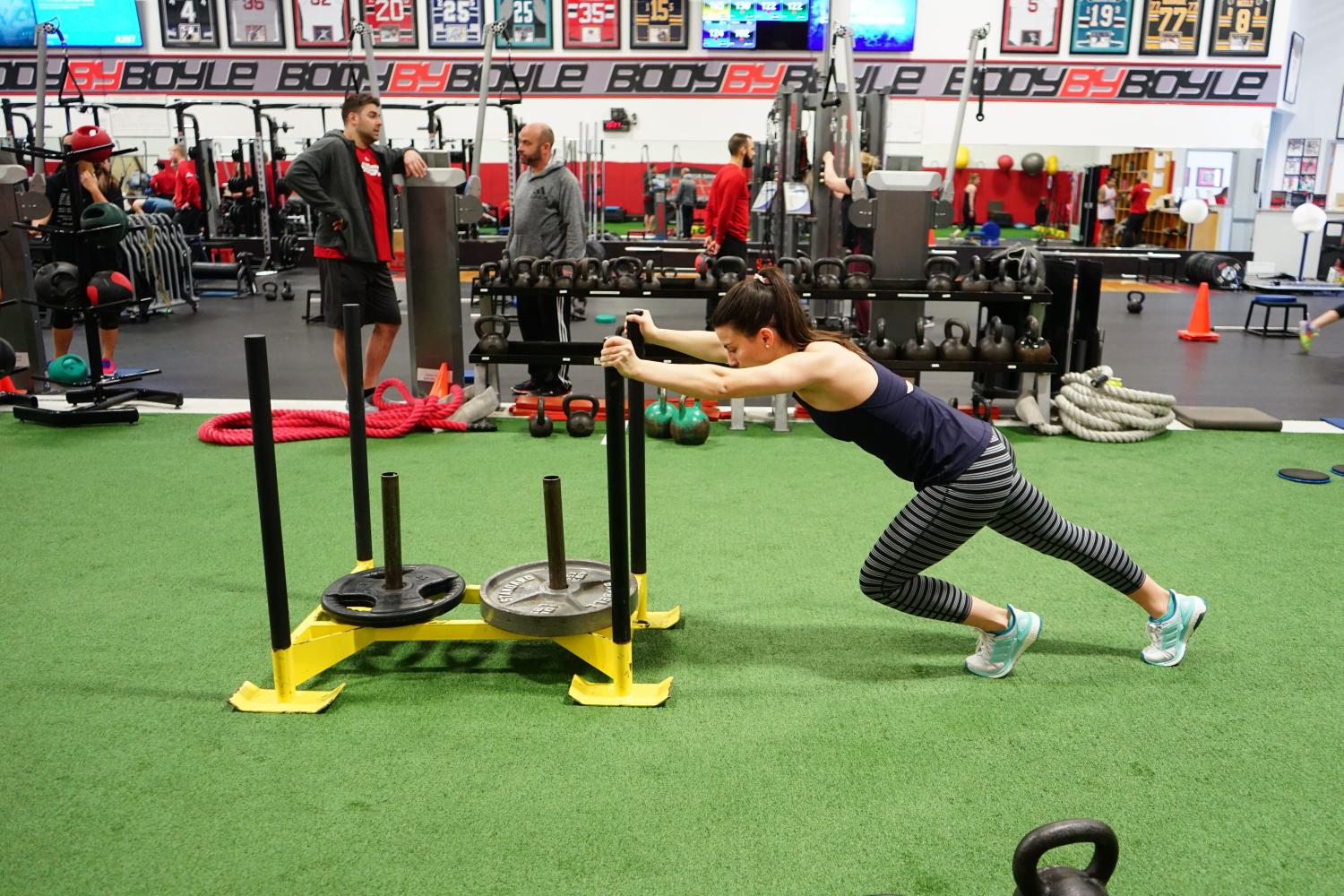
Want to learn how your fitness business can take it to the next level? Get a demo now!









